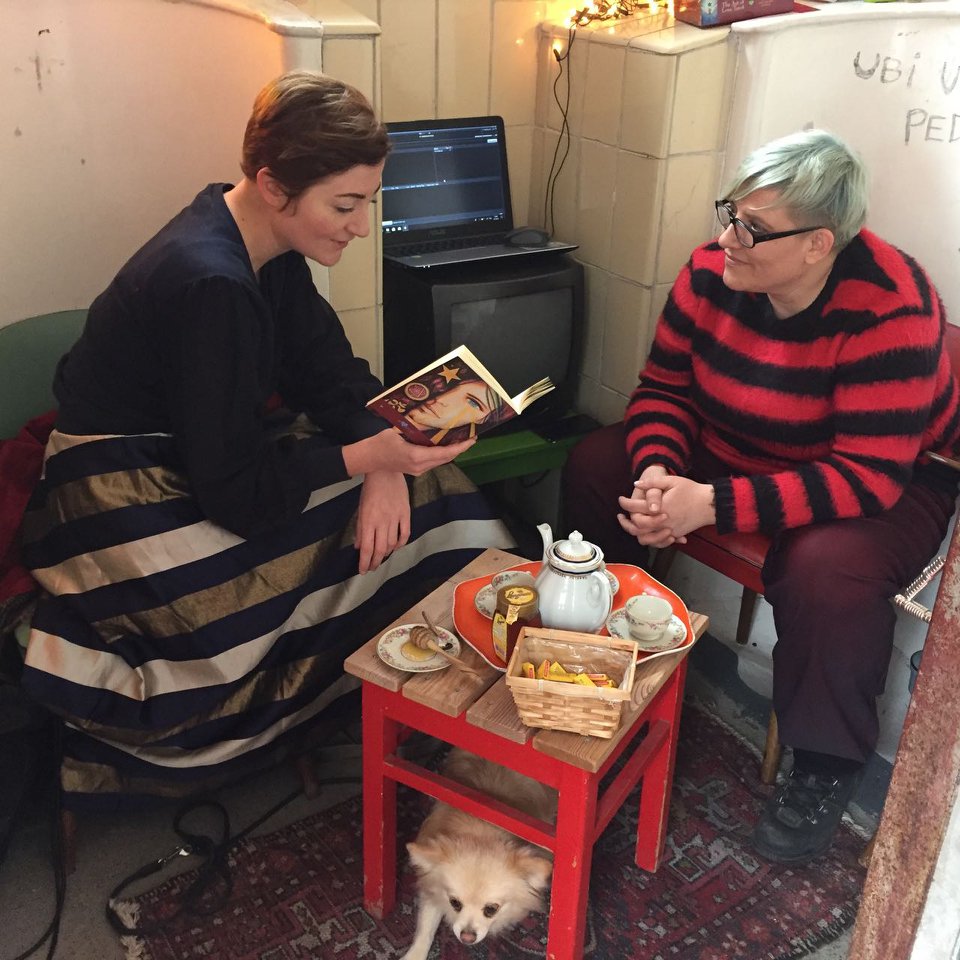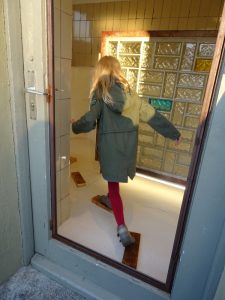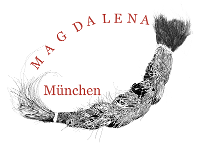Frauen-Theater-Performance
Art and Understanding

Having been at the first Magdalena Festival in 1986 and many since in many parts of the world, this Munich Magdalena has a very different feel, due to the Munich City supported artists’ residency scheme which gives the festival its three month shape.
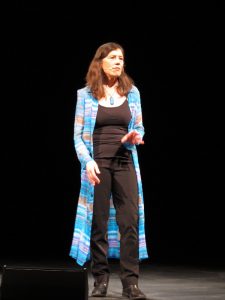 I was welcomed for a month’s residency at Ebenböckhaus where I was given a beautiful large light room facing onto a garden. After the busyness and noise of East London where I live it is the perfect environment to concentrate and let the mind expand into new ideas. I was working on a performance based on stories and interviews around the theme of TRUTH.
I was welcomed for a month’s residency at Ebenböckhaus where I was given a beautiful large light room facing onto a garden. After the busyness and noise of East London where I live it is the perfect environment to concentrate and let the mind expand into new ideas. I was working on a performance based on stories and interviews around the theme of TRUTH.
The length of my stay incorporated two solo shows in theatres with excellent acoustics (HochX and Meta Theater) and a singing workshop with a talented international group of artists, theatre makers and singers. Through these activities and at other performances and events, I met a huge range of women creators in Munich as well as international women in residence at the Villa Waldberta. Alongside the individual creativity that each artist is involved in, conversations led to collaborations, and collaborations led to further creativity. Interviews were made, recordings, further collaborations planned, art works created, songs composed and ideas for a voice festival developed. This was a new experience in a Magdalena festival where normally the span of the festival would be ten days or two weeks; artists would be busy preparing their performances or giving workshops, and have little or no time to develop their latest work or to collaborate truly with others in a way that comes naturally out of conversations and meetings over time.
Gilla Cremer erhaltet Hamburgs Top-Kulturpreis

Gilla Cremer, die am 20.04. in der Magdalena München Saison auftretten werdet, hat gestern Hamburgs Top-Kulturpreis bekommen.
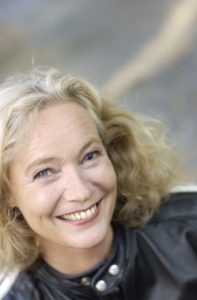 Gänsehaut-Moment Hamburgs Top-Kulturpreis als Überraschung
Gänsehaut-Moment Hamburgs Top-Kulturpreis als Überraschung
Sie trägt Hamburgs guten Ruf in die Welt: Theatermacherin Gilla Cremer.
Am Ende regnete es rote Rosen – für Gilla Cremer (61), die zum 30-jährigen Jubiläum ihres Theaters Unikate am Freitag in den Kammerspielen gefeiert wurde. Wie auf jeder tollen Geburtstagsfeier gab es auch hier eine tolle Überraschung: Kultursenator Carsten Brosda (SPD) verlieh der Künstlerin die Senator-Biermann-Ratjen-Medaille, einen der wichtigsten Kulturpreise der Stadt!
Auf ungläubiges Staunen im Gesicht der Geehrten folgte kollektive Gänsehaut im Publikum – und dann riesiger Jubel. Die Künstlerin sei “nach John Neumeier die zweite Person, die seit Jahrzehnten als Botschafterin der Stadt” Hamburgs guten Ruf in die Welt trägt, so die Begründung. 26.03.18 Dagmar Ellen Fischer / Mopo
Biermann-Ratjen-Medaille für Gilla Cremer
“Halbzeit” hatte Gilla Cremer das 30. Jubiläum ihres Ein-Frau-Unternehmens “Theater Unikate” selbstironisch genannt, und viele, viele Weggefährten aus der Theaterszene kamen, um zu gratulieren. Dass es sich bei ihr tatsächlich um ein Unikat handelte, bewies nicht zuletzt Kultursenator Carsten Brosda, der Gilla Cremer für ihre Verdienste um die Hamburger Kultur zu diesem Anlass die Senator-Biermann-Ratjen-Medaille überreichte, für “politisches Theater im allerbesten Sinne” von einer “Theatermacherin, der nie die Puste ausging”.
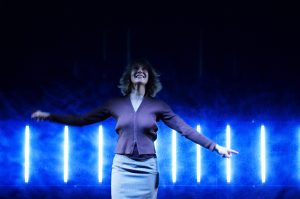 Für die Bewältigung der Langstrecke allein gibt es solch renommierte Auszeichnungen natürlich nicht. Bevor Cremer sich also selbst in einer “Roadshow” durch die 30 nicht immer geraden Jahre spielte und erzählte, lobte Brosda die “unvergleichliche Hingabe, Sorgfalt und Professionalität” dieser zugleich lässigen und kompromisslosen Bühnenfrau. Sie — stets Hauptdarstellerin, Stückeerfinderin, “Intendantin”, Lichtmeisterin, Bühnenarbeiterin in einer Person — sei mit ihren Gastspielen (die sie auch auf Englisch spielt und die sie bis nach Taiwan und Neuseeland führten) auch “eine Botschafterin der Stadt”. Bis Jahresende sind fast alle Unikate-Stücke noch einmal an den Kammerspielen zu sehen. Maike Schiller / Hamburger Abendblatt
Für die Bewältigung der Langstrecke allein gibt es solch renommierte Auszeichnungen natürlich nicht. Bevor Cremer sich also selbst in einer “Roadshow” durch die 30 nicht immer geraden Jahre spielte und erzählte, lobte Brosda die “unvergleichliche Hingabe, Sorgfalt und Professionalität” dieser zugleich lässigen und kompromisslosen Bühnenfrau. Sie — stets Hauptdarstellerin, Stückeerfinderin, “Intendantin”, Lichtmeisterin, Bühnenarbeiterin in einer Person — sei mit ihren Gastspielen (die sie auch auf Englisch spielt und die sie bis nach Taiwan und Neuseeland führten) auch “eine Botschafterin der Stadt”. Bis Jahresende sind fast alle Unikate-Stücke noch einmal an den Kammerspielen zu sehen. Maike Schiller / Hamburger Abendblatt
In the Middle of the Magdalena Marathon
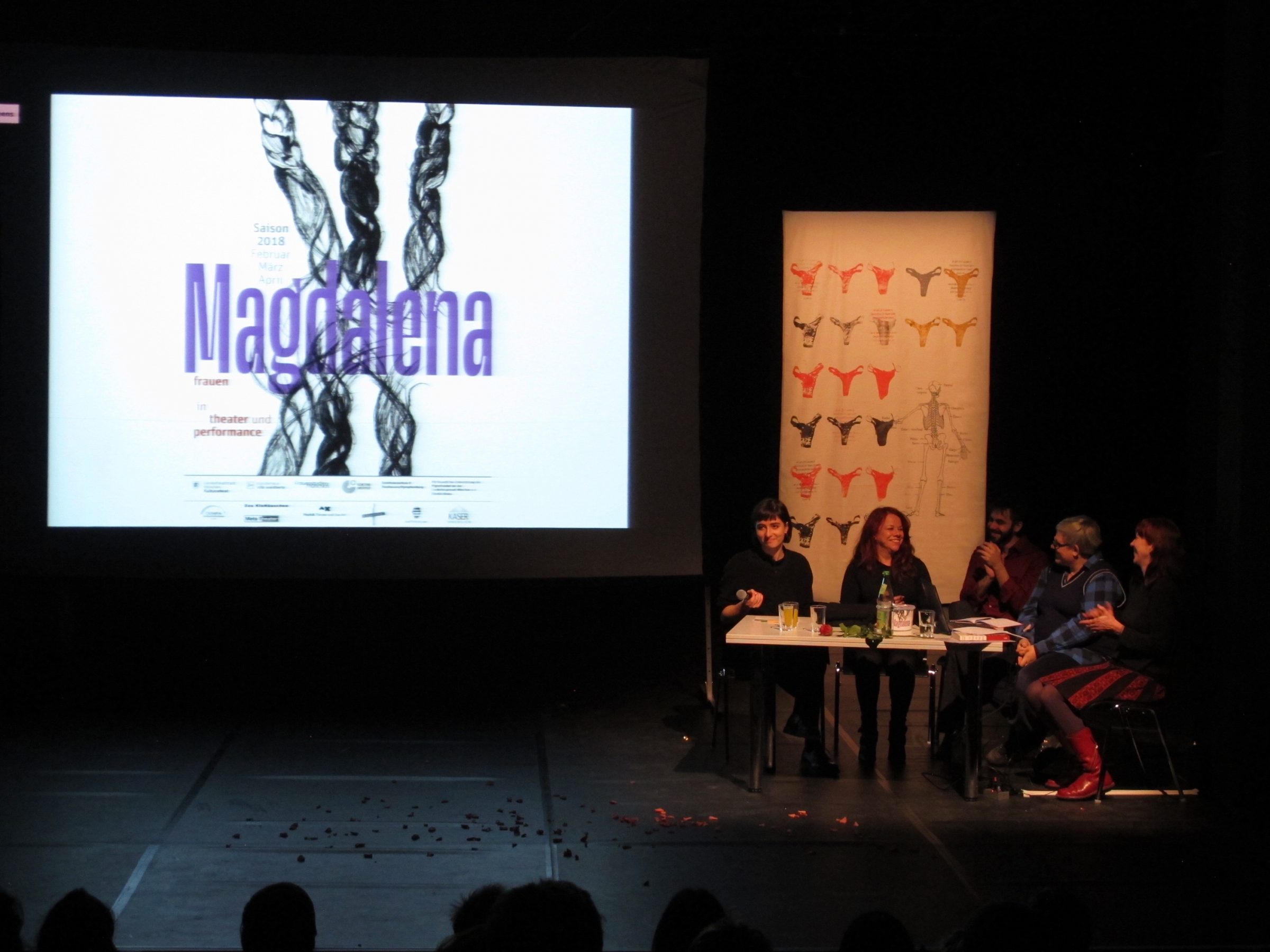
It’s the middle of March and the middle of the Magdalena München Saison: six weeks behind us, six weeks ahead. Time to pause and take a breath, look back at what’s happened and gather our energies for the next stretch!
February guests Jana Korb, Deborah Hunt and Zoe Gudović have now all returned to their homes in Berlin, Puerto Rico and Belgrade. Deborah has written about her experiences here, and we are expecting reports from Jana and Zoe. For all of them, as well as for Thaís Medeiros and Kordula Lobeck de Fabris who are here for the whole three months, February was a very busy time. Performances, workshops and Zoe’s installation at das KloHäuschen, as well as social gatherings and adventures with public transport quickly filled the month. All of the events were successful, even if the audiences could have been bigger, and we achieved a lot of coverage in the newspapers. Excitingly, all of the artists made new connections and have talked of returning for future projects and collaborations.
For the local Magdalena team, it’s been six weeks of juggling our ongoing work and family commitments with organisational duties, documentation, hosting – and attending performances, participating in workshops and spending time with the visiting artists. At the beginning of March the team happily welcomed two additional volunteers – our intern Gina Saggiante, and Vedanth Ramesh who has come all the way from India to help and participate.
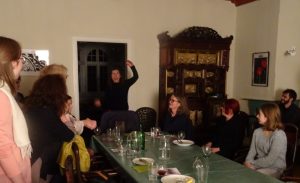 March has an unofficial theme of songs and singing, with Teatret OM arriving from Denmark and presenting their song-based performance “I Maltagliati“, Helen Chadwick from London performing “Fragments of Love” and giving a Harmoniegesang workshop, and Elis & Catherine (from Munich and Boston) performing their Brasilian music concert “Um Gosto de Sol“. The March “Jourfix” at the Villa Waldberta celebrated song, with both guest artists and local Munich artists singing and teaching songs, which everyone joined in. At left, Helen Chadwick leads us in a two-part harmony.
March has an unofficial theme of songs and singing, with Teatret OM arriving from Denmark and presenting their song-based performance “I Maltagliati“, Helen Chadwick from London performing “Fragments of Love” and giving a Harmoniegesang workshop, and Elis & Catherine (from Munich and Boston) performing their Brasilian music concert “Um Gosto de Sol“. The March “Jourfix” at the Villa Waldberta celebrated song, with both guest artists and local Munich artists singing and teaching songs, which everyone joined in. At left, Helen Chadwick leads us in a two-part harmony.
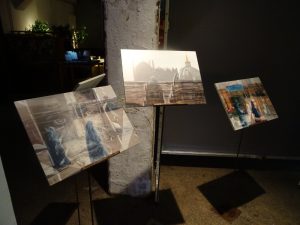 But it’s not only about song. March began with Kordula Lobeck de Fabris’ multimedia installation “Unsichtbare Orte – Weil das Leben ein Geschenk ist“, featuring the work of Afghani teenagers with whom Kordula has collaborated over the last two years. The material gives a fascinating insight into their lives and how they are adapting to living in Germany. Two of the youths, Navid and Hasib, came to Munich and shared their experiences of both life and the project in a networking and exchange event. Kordula is now working with a group of women on “Unsichtbare Orte – Frauen in der Kunst“, which will follow a similar form to the previous “Unsichtbare Orte” installations but with completely new material that explores women artists’ “invisible spaces”. This will also be shown at PATHOS Theater, from 18 to 22 April.
But it’s not only about song. March began with Kordula Lobeck de Fabris’ multimedia installation “Unsichtbare Orte – Weil das Leben ein Geschenk ist“, featuring the work of Afghani teenagers with whom Kordula has collaborated over the last two years. The material gives a fascinating insight into their lives and how they are adapting to living in Germany. Two of the youths, Navid and Hasib, came to Munich and shared their experiences of both life and the project in a networking and exchange event. Kordula is now working with a group of women on “Unsichtbare Orte – Frauen in der Kunst“, which will follow a similar form to the previous “Unsichtbare Orte” installations but with completely new material that explores women artists’ “invisible spaces”. This will also be shown at PATHOS Theater, from 18 to 22 April.
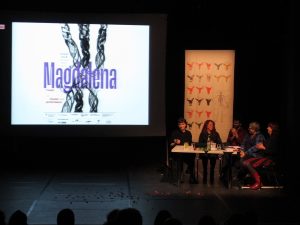 “Feministischer Aktivismus als Performance” was the topic on 6 March, where we witnessed the performance “Tapete Manifesto“, by Thaís Medeiros and her workshop participants (Sabine Bollenbach, Cecilia Bolaños, Cordula Trapp and Zoe Gudović), with drums by Ivan Medeiros. The performance presents brutal statistics and realities about violence against women in a way that is poetic, beautiful and provocative. Following the performance there was a panel discussion, where I dedicated the evening to the late performance artist and gender activist Diane Torr, and both Thaís and Zoe Gudović spoke about how they use performance as a tool for feminist activism, and how activism informs their artistic work. The event was moderated by Maria Fedorova and we had a good discussion with the audience after the presentations.
“Feministischer Aktivismus als Performance” was the topic on 6 March, where we witnessed the performance “Tapete Manifesto“, by Thaís Medeiros and her workshop participants (Sabine Bollenbach, Cecilia Bolaños, Cordula Trapp and Zoe Gudović), with drums by Ivan Medeiros. The performance presents brutal statistics and realities about violence against women in a way that is poetic, beautiful and provocative. Following the performance there was a panel discussion, where I dedicated the evening to the late performance artist and gender activist Diane Torr, and both Thaís and Zoe Gudović spoke about how they use performance as a tool for feminist activism, and how activism informs their artistic work. The event was moderated by Maria Fedorova and we had a good discussion with the audience after the presentations.
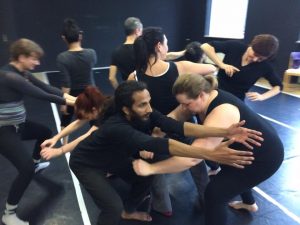 Last weekend Teatret OM’s workshop “The Presence of Emptiness” was an intense and inspiring experience. Over the course of two days, as well as learning some of the group’s regular training methods, we undertook a devising process and created a 10 minute performance that started from literally nothing. Scenographer Antonella Diana proposed blankets as objects to work with, we generated actions through a number of exercises, and director Sandra Pasini made decisions that shaped the material in such a way that stories began to naturally emerge. It was a very clear demonstration of the creative methods that Teatret OM has developed over 30 years of theatre research. Three days later, my legs are still a little bit sore from the Wind Dance, and my mind is alive with possibilities of applying some of these techniques in my own work.
Last weekend Teatret OM’s workshop “The Presence of Emptiness” was an intense and inspiring experience. Over the course of two days, as well as learning some of the group’s regular training methods, we undertook a devising process and created a 10 minute performance that started from literally nothing. Scenographer Antonella Diana proposed blankets as objects to work with, we generated actions through a number of exercises, and director Sandra Pasini made decisions that shaped the material in such a way that stories began to naturally emerge. It was a very clear demonstration of the creative methods that Teatret OM has developed over 30 years of theatre research. Three days later, my legs are still a little bit sore from the Wind Dance, and my mind is alive with possibilities of applying some of these techniques in my own work.
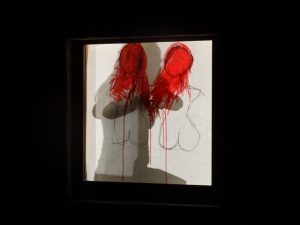 An important aspect of the Magdalena Saison is working with different venues and spaces to reach a variety of audiences and generate collaborations between different parts of Munich’s independent arts community. Our performances are mainly at HochX and Meta Theater – both very special performance spaces for different reasons, HochX being a beautiful historic theatre with a vibrant young team, and Meta Theater being designed and built by architect/director Axel Tangerding as his home and theater for over 30 years. We have also performed at the Olympia Einkaufszentrum, and are collaborating with two unique projects: “Break through” and das KloHäuschen. Last Sunday Thaís Medeiros performed “Janela Manifesto” in the “Break through” space – a 1m x 1m window in Dorothea Seror‘s atelier. Thaís used elements from “Tapete Manifesto” and transformed the window into a canvas, working with paint and shadow. Claudia Urrutia will develop the 21st “Break through” performance, to be presented on 11 April.
An important aspect of the Magdalena Saison is working with different venues and spaces to reach a variety of audiences and generate collaborations between different parts of Munich’s independent arts community. Our performances are mainly at HochX and Meta Theater – both very special performance spaces for different reasons, HochX being a beautiful historic theatre with a vibrant young team, and Meta Theater being designed and built by architect/director Axel Tangerding as his home and theater for over 30 years. We have also performed at the Olympia Einkaufszentrum, and are collaborating with two unique projects: “Break through” and das KloHäuschen. Last Sunday Thaís Medeiros performed “Janela Manifesto” in the “Break through” space – a 1m x 1m window in Dorothea Seror‘s atelier. Thaís used elements from “Tapete Manifesto” and transformed the window into a canvas, working with paint and shadow. Claudia Urrutia will develop the 21st “Break through” performance, to be presented on 11 April.
Also in March the Süddeutsche Zeitung announced that das KloHäuschen is one of the winners of the Tassilo-Kulturpreis – well deserved, and undoubtedy helped by the success of Zoe’s installation “DISSOCIATION” in February! Magdalena is back at das KloHäuschen on 29.03. with “Der Wechsel” from MarinA.
It’s quite overwhelming to look back on all of this activity, that began a year ago with conversations and emails, then became a programme printed on paper, and has now manifested into living breathing events that have touched so many people. We are half way through the marathon and looking forward with anticipation at the programme for April!
Thoughts about Magdalena Munich Saison 2018
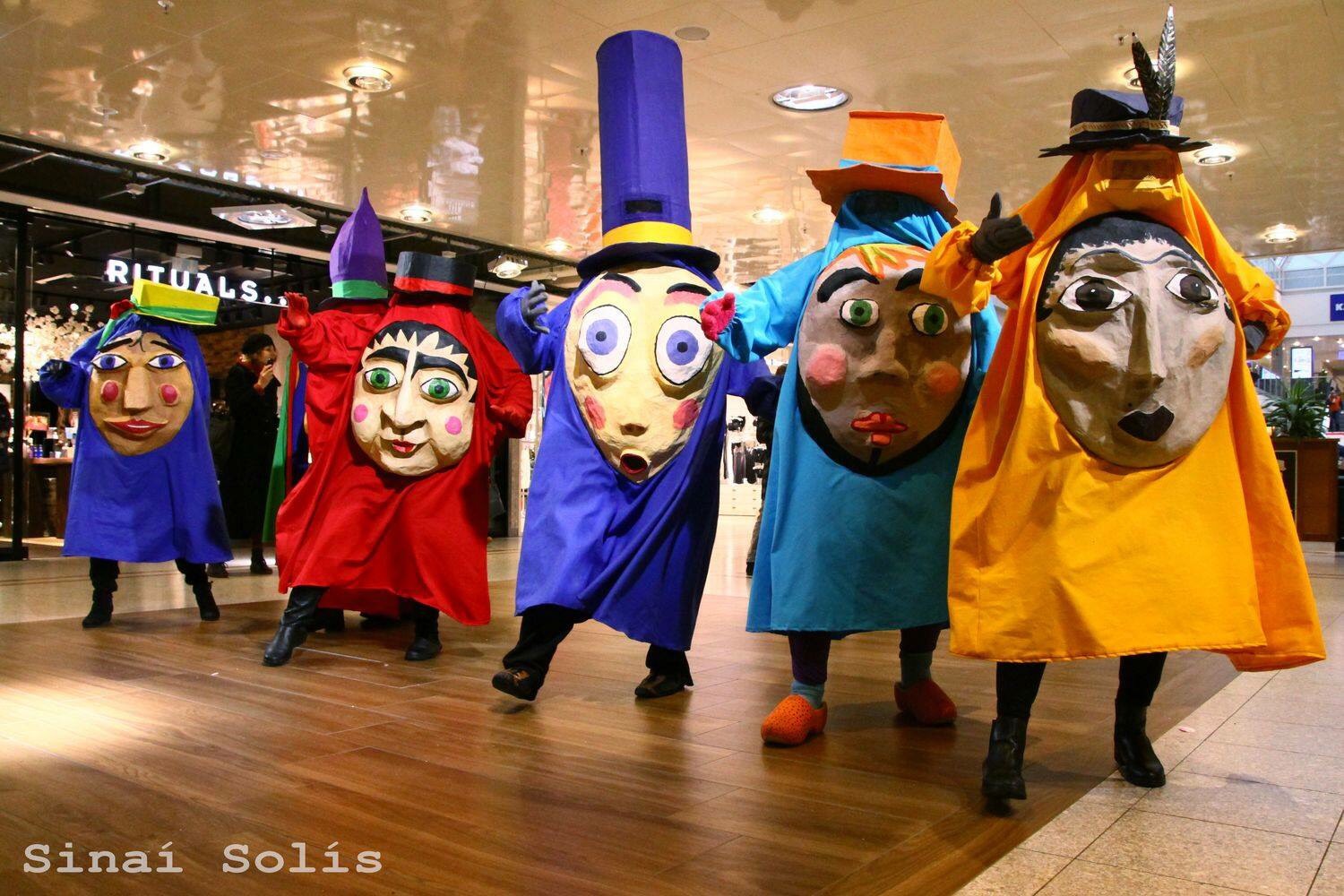
This Helen Varley Jamieson sure does know how to jump in the deep end. To extend a Magdalena event for three months is no easy feat especially with limited resources and personal. My hat off to her.
My participation was to perform “Tale 53: Snowhite” for the opening of the Saison at HochX,; perform the same work the next night; conduct a five day bodymask building workshop “Macanudos” finishing with a parade / intervention in a large shopping mall and roundoff with Tale 53 again at Meta Theatrer. All doable. It is often difficult coming to a new place and having to figure out materials etc and all this was cheerfully carried out with Helen and also my workshop assistant Sabine Bollenbach. This was a new workshop so there are always uncertainties. The opening night performance was cancelled because my luggage had not arrived (never fly British Airways) but fortunately it did for the second night, so onwards.
The artists for the season all stay at Villa Waldberta, in Felding, about 30 minutes by train from the centre of Munich. Once the house (1900s) of wealthy people it is now a very agreeable place to stay, work, collaborate, eat together if we wish, never see a soul if we like and above all have time to think and work on other projects. There is precious time and for this I thank Helen, and Karin Sommer from the Villa Waldberta. A house full of Magdalenas is really a privileged situation and although we all have our own apartments; the times of sharing as always are great. With snow all around, it has been like living in a Christmas card; a far cry from the post Hurricane Maria circumstances of Puerto Rico, which is my home.
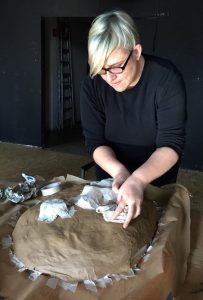
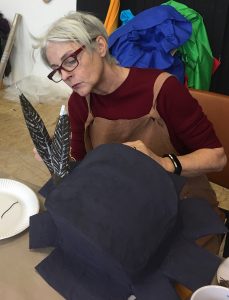
The mask workshop was intense and the parade joyful. I have never been drawn to perform in shopping malls and actually they are often off limits to us, wherever we might be. The mall was full of all kinds of folk and the participants of the workshop had the opportunity to move into the flow of the parade and practised secuences of simple movements and also on a personal level, establish contact with members of the public. I was pleased with the outcome.
Tomorrow I perform for the last time in Munich at Meta Theater …. I feel anxious and at the same time content that phase one of the deep end is for me nearly accomplished. Thank you Helen. May we keep jumping.
Deborah Hunt
MASKHUNT MOTIONS
www.facebook.com/maskhunt
http://hemisphericinstitute.org/artistprofiles/index.php?lang=Eng&Artist=dhunt&Menu=About&Category=Bio
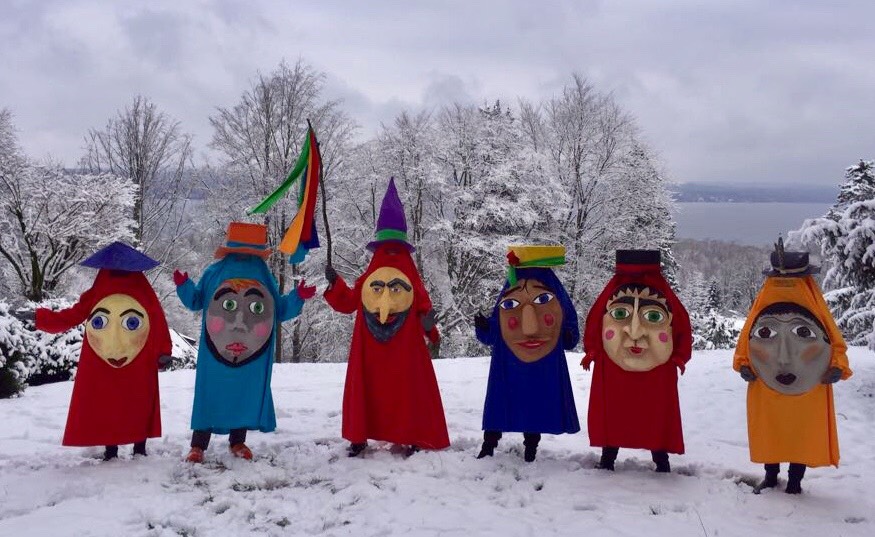
Der Wechsel – MarinA
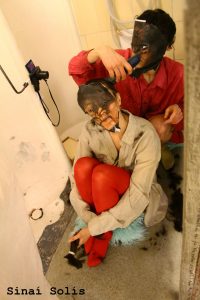 29.03 19:00 : Performance, Das KloHäuschen
29.03 19:00 : Performance, Das KloHäuschen- Infos auf KloHäuschen Webseite
- Fotogalerie
MarinA lädt am Tag des letzten Abendmahls in Das KloHäuschen ein – eine Performance für diesen wunderschönen Ort im Rahmen der Magdalena Saison entwickeln zu dürfen hat sie sehr gefreut!
Anders als jetzt vielleicht vermutet dreht es sich in dieser Performance nicht ums Essen, das Thema ist die eher Veränderung. Das Vorher und Nachher. Der innere und äußere Wechsel durch die Tat.
MarinA arbeitet im KloHäuschen mit Masken, mit Pflegemitteln, mit Zuwendung, mit Beratung, mit Veränderung.
Wie das KloHäuschen ein hybrider Ort ist, so ist es auch die Performance von MarinA. Privat, öffentlich, pflegend, verschandelnd, die Grenzen sind fließend und unklar die Begrifflichkeiten. Der Beobachter wird außerhalb gehalten und doch wird ihm der Einblick aktiv ermöglicht.
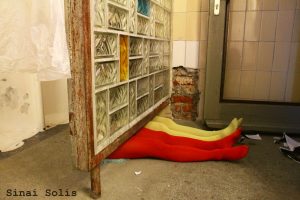 Eine Frage der Balance zwischen A und M, so beschreibt MarinA sich selbst. Sie ist ein deutsch-italienisches Künstlerinnenduo, 2015 aus Proseccoschaum geboren, aus der Berührung von Malerkrepp und Nase, während eines telepathischen Experiments.
Eine Frage der Balance zwischen A und M, so beschreibt MarinA sich selbst. Sie ist ein deutsch-italienisches Künstlerinnenduo, 2015 aus Proseccoschaum geboren, aus der Berührung von Malerkrepp und Nase, während eines telepathischen Experiments.
Ihre ersten Worte waren SI und NO. Aus gegebenem Anlass ist Kommunikation in allen Varianten das Hauptthema ihrer Arbeit.
Aber auch unabhängig von den persönlichen Gegebenheiten ist Kommunikation eines der interessantesten Felder unserer Gesellschaft.
Nicht erst in letzter Zeit.
Wir sind eine Gruppe, eine Herde. Schon immer ging es darum Information innerhalb dieser Gruppe weiterzugeben, sich mitzuteilen, auszudrücken, abzustimmen.
Und so geht es MarinA auch im KloHäuschen um Kommunikation und ihre Folgen, Kommunikation mit dem Nächsten, dem Ort – mit sich.
Quando per la prima volta è entrata in Das-Klohäuschen, MarinA ha visto delle gam- be colorate spuntare dal muro vetrato al suo interno.
Dietro quella parvenza di intimità e discrezione compierà i suoi cambiamenti, lascerà tracce ed un’offerta, mostrandosi al pubblico in un riffleso.
La casualità della data scelta, il giovedì santo, i numeri che questa ricorrenza porta con sè ed il fatto che “Der Wechsel” sia in collaborazione con il Magdalena Season ha fatto sí che MarinA attraversasse il mistero religioso e considerasse la donna da altri e più punti di vista.
Tali riferimenti, seppur secondariamente, hanno contribuito alla nascita di un lavoro testuale ed iconogra co interno e complementare a quella che sarà la performance stessa.
Tredici volumi conterranno 40 autoritratti e gli scritti formatisi nel periodo di incuba- zione del cambiamento.
L’unicità di Klohäuschen e le visioni giocose di MarinA, miste alla sua scienza prefer- ita, il Caso, hanno portato a “Der Wechsel”.
Il cambiamento.
MarinA ringrazia.
The Change
MarinA invites you to Das KloHäuschen on the day of the Last Supper – she is delighted to be able 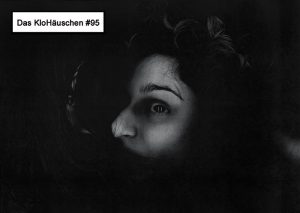 to develop a performance with this beautiful place as part of the Magdalena season!
to develop a performance with this beautiful place as part of the Magdalena season!
Contrary to what you may expect, this performance is not about food, rather the theme is change: the before and after. The inner and outer change throughout the act. MarinA works in das KloHäuschen with masks, with beauty products, with attention, with advice, with change. As das KloHäuschen is a hybrid place, so is the performance of MarinA. Private, public, nurturing, corrupting, the boundaries are fluid and the terminology is ambiguous. The observer is kept outside and yet insight is actively enabled.
MarinA describes herself as a question of balance between A and M. She is a German-Italian artist duo, born in 2015 from Prosecco bubbles, from the touch of masking tape and nose during a telepathic experiment. Her first words were SI and NO. For this reason, communication in all its variations is the main theme of her work. But regardless of personal circumstances, communication is one of the most interesting fields of our society. Not only recently. We are a group, a herd. Information has always been passed around within this group, communicating, expressing and coordinating.
And so MarinA and das KloHäuschen is also about communication and its consequences – communication with the neighbor, the place – with itself.
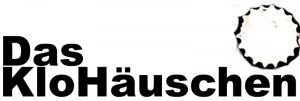
Die Saison fängt an!

We are now one week into the Magdalena München Saison 2018, and already a lot has happened! The February artists have arrived in Munich and settled into the Villa Waldberta in Feldafing, and their performances, workshops and projects are underway.
Photo Gallery || Photos on Facebook
Our opening on Friday 02.02. and Saturday 03.02. was warmly received. A good-sized audience was gathered i the foyer of HochX, when a masked figure (Cecilia Bolaños) appeared on the stairs, singing and drumming. She moved through the audience, singing and making contact with people, before leading everyone into the theatre space and all the way onto the stage. There, Martina Marini Misterioso gave her performance Final Act, a quiet meditation on the concepts of home and belonging.
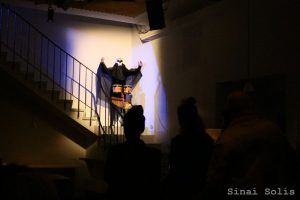
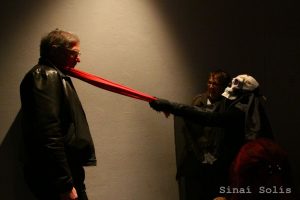
As the audience sat contemplatively on the stage, drums and calling came from the theatre’s gallery. A regal figure (Sabine Bollenbach) in a long flowing sparkly blue gown that extended into the seating welcomed us – to HochX, to the centenary of women’s suffrage in Germany, and to the Magdalena München Saison. Her speech described Magdalenas and gave hints at the performances and events to come in the programme. Then she invited the public to be seated, and we listened to the beautiful music of Elis Roseira. I introduced the artists and spoke about Magdalena, then we heard more from Elis.
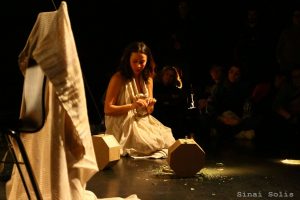
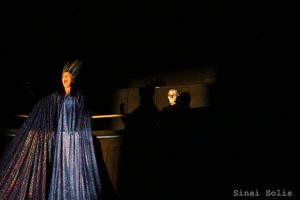
Unfortunately the second half of our opening programme had had to be changed due to the non-arrival of Deborah Hunt‘s luggage, containing all of her puppets, props, costumes and scenery required for Tale 53; Snowhite. We screened the documentary film Magdalena instead, and then had an extra surprise finale to the evening when, as we sat in the foyer with a glass of wine after the film, the three missing suitcases arrived! It was a jubilant moment and a big relief. The show would go on!! And it did, on the following night, to an enthusiastic audience. Everyone stayed afterwards to hear an impromptu discussion from Deborah, explaining the various puppetry techniques she had employed and allowing us to have a close look at everything. Deborah will perform Tale 53; Snowhite once more, on Saturday 24 February at Meta Theater (Moosach bei Grafing).
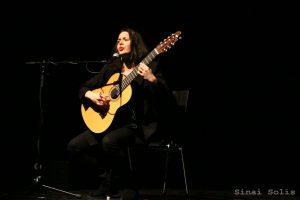
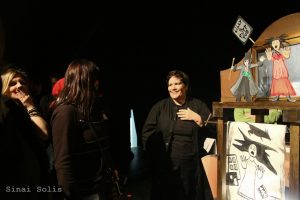
Throughout the opening weekend, a beautiful video installation by the visual artist Laia Martí Puig was shown in the foyer of HochX. Projected down onto the surface of the bar, a looping video showed Laia’s hands peeling onions, surrounded by onion skins. The video is both artwork and documentation of her ongoing project with the onion skins. Look out for it when Magdalena is again in HochX!
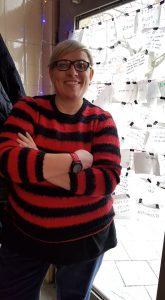 On Saturday 03.02., Zoe Gudović opened her performance installation DISSOCIATION, in collaboration with Das KloHäuschen. She has transformed this former men’s public urinal into her living room, and invites the public to visit her, to drink tea with her, and to speak about love – in the context of her story of the 2001 Belgrade Gay Pride march, where violent thugs attacked peaceful marchers. Visitors then write something about love on a piece of toilet paper and this is hung in the KloHäuschen’s glass door. So many people came on the first day (they were “giving each other the doorhandle”) that the glass door was quickly filling up with people’s messages.
On Saturday 03.02., Zoe Gudović opened her performance installation DISSOCIATION, in collaboration with Das KloHäuschen. She has transformed this former men’s public urinal into her living room, and invites the public to visit her, to drink tea with her, and to speak about love – in the context of her story of the 2001 Belgrade Gay Pride march, where violent thugs attacked peaceful marchers. Visitors then write something about love on a piece of toilet paper and this is hung in the KloHäuschen’s glass door. So many people came on the first day (they were “giving each other the doorhandle”) that the glass door was quickly filling up with people’s messages.
Also on the 3rd and 4th of February, Jana Korb gave her workshop Kreation im begrenzte Raum (Creation in Confined Space). Some of the participants came with their “confined space”, such as a suitcase, or a box, while others worked with Jana’s trapaze and other limitations that they found in the workshop space. They all found this idea of operating within limitations to be very inspiring.
The monthly “Jourfix” at the Villa Waldberta took place last Thursday. This is an informal party and an opportunity for the resident artists to meet local people from Feldafing and from the Munich arts scene. Often the artists give presentations or small performances, and naturally the “Villa Magdalena” artists put together a wonderful show. Deborah Hunt’s Macanuda mask character acted as our guide, leading us to the Palmenhaus for a preview of Kordula Lobeck de Fabris‘ multimedia installation Unischtbare Orte – das Leben ist ein Geschenk, and a work-in-progress from Jana Korb. Back at the Villa, Zoe Gudović gave a presentation about her street performances highlighting violence against women in Serbia, and the programme concluded with a taste of Tapete Manifesto from Thaís Medeiros and Ivan Medeiros Masocatto.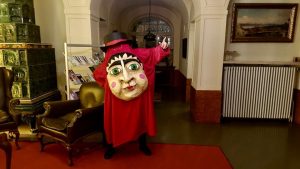 Today the Macanudos workshop is underway, the participants are busy making the masks and costumes that they’ll wear for the parade at Olympia Einkaufszentrum this coming Saturday. I’m busy catching up on admin and emails, and trying to finish this blog post that I began almost a week ago!
Today the Macanudos workshop is underway, the participants are busy making the masks and costumes that they’ll wear for the parade at Olympia Einkaufszentrum this coming Saturday. I’m busy catching up on admin and emails, and trying to finish this blog post that I began almost a week ago!
Las Otras Americanas
-
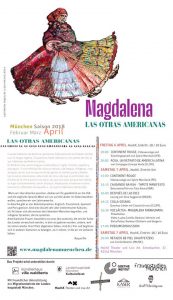 06.04.19:00, HochX
06.04.19:00, HochX
- Continent Rouge, Video Auszüge / video excerpts und Künstlergespräch von Sylvie Marchand (Frankreich)
- Rosa, un retrato de America latina, Aufführung von Claudia Urrutia, Compagne Zumaya Verde (Chile/Frankreich)
- 07.04, 15:00-18:00, HochX
- Continent Rouge, Video Auszüge / video excerpts und Künstlergespräch von Sylvie Marchand (Frankreich)
- Causando na Rua – Tapete Manifesto, Dokumentarfilm, directed by Tata Amaral and produced by Tangerina Entretenimento
- Después de las Diezį Lesung von Georgina Saggiante Montero (MX/DE)
- Colla Gesang, Quechua Lieder mit Claudia Urrutia (CL/FR)
- VOZ LÁCTEA – Magdalena Tarahumara vorgestellt von Sylvie Marchand, Claudia Urrutia und Raquel Ro (Spanien/Deutschland); Video: Lupita Castillo, Rarámuri Lehrerin und Elvira Palma, Rarámuri Dichterin und Sängerin.
- Podiumsdiskussion
- 07.04., 20:00, HochX
- Retazos de piel (Hautfetzen), Aufführung von Cecilia Bolaños (Mexiko/DE)
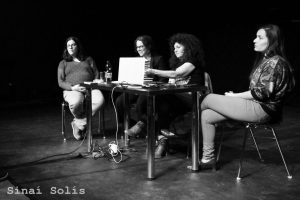
Wenn wir über Amerika sprechen, denken wir für gewöhnlich an die USA und die englische Sprache.Wenn wir uns auf die Länder im Süden beziehen wollen, sprechen wir von Lateinamerika.
In Amerika gibt es vier Kolonialsprachen, Englisch, Französisch, Spanisch und Portugiesisch. Und eine Unzahl sehr alter einheimischer Kulturen, als Teil derer sich die meisten dort lebenden Menschen begreifen, und indigener Sprachen, die sie sprechen.
Amerikanische Frauen, besonders las otras (die anderen), die mit der Farbe des Landes verwechselt werden, in dem sie geboren wurden, andere, weil sie immer wieder ihren Platz abgetreten haben, sind da / hier und beginnen sich in anderen Szenarien zu bewegen, als in denen, in die wir sie verbannt haben.
English:
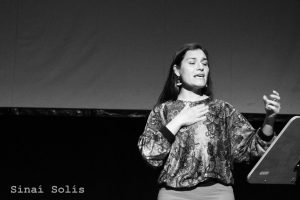
When we talk about America, we usually think of the United States and the English language. If we want to refer to the countries further south, we say Latin America.
But in America, there are four colonizing languages – English, French, Spanish and Portuguese – and myriad ancient native cultures and indigenous languages, something of which most people living there understand and speak.
American women, especially las otras (the others), those who are coloured by the land that saw them being born, who are others because they have constantly relinquished their place, are there / here, beginning to move in other scenarios, different from those to which we had banished them.
Español:
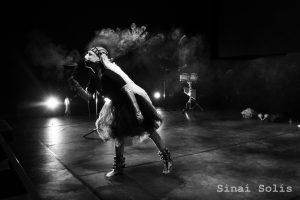 Cuando hablamos de América, pensamos habitualmente en Estados Unidos y en la lengua inglesa. Si queremos hacer referencia a los países de más al sur, hablamos de América Latina.
Cuando hablamos de América, pensamos habitualmente en Estados Unidos y en la lengua inglesa. Si queremos hacer referencia a los países de más al sur, hablamos de América Latina.
En América hay cuatro lenguas colonizadoras, inglés, francés, español y portugués. Y una infinidad de culturas nativas y de lenguas indígenas, muy antiguas, de las que la mayoría de las gentes se sienten parte y hablan.
Las mujeres americanas, sobre todo las otras, las que se confunden con el color de la tierra que las vio nacer, las que son otras porque han cedido su lugar constantemente, están ahí/aquí, empezando a moverse en otros escenarios, diferentes de aquellos a los que las habíamos desterrado.
Der Countdown läuft!
In weniger als zwei Wochen eröffnet die Magdalena München Saison 2018 mit einem besonderen Eröffnungsabend im HochX. Wir arbeiten seit fast einem Jahr an diesem Projekt – ein kleines Team mit begrenzten Ressourcen, angetrieben von einer Menge wundervoller Magdalena-Energie!
Heute ist das erste unserer Werbematerialien angekommen, und es sieht sehr schön aus! Die letzten zwei Wochen waren wir sehr beschäftigt – umso spannender ist es, es in Händen zu halten. Raquel Ro hat lange Nächte gearbeitet, Mira Mazumdar hat an den schönen Übersetzungen gearbeitet und Sabine Bollenbach hat sorgfältig Korrektur gelesen. Designerin Carina Müller sprang mit einigen wunderbaren Ideen ein, die unsere Werbematerialien auf ein neues Niveau gehoben haben. Ein besonderes Detail ist die Schriftart, die für das Wort “Magdalena” verwendet wird. Es ist eine brandneue Schrift, die noch nicht fertiggestellt oder öffentlich verfügbar ist, aber ihre Schöpferin, Inge Plönnings, hat uns großzügig erlaubt, sie zu benutzen. Der schöne Zufall ist, dass Inge dieser Schriftart den Namen “Magnet” gegeben hat. Diejenigen von uns, die auf der Magdalena-Projekt-Website arbeiten, nennen sie selbst “die Magnetics”, und wir sind alle Teil des MAGdalena-NETzwerks, also ist eine Schrift namens Magnet sehr passend!
Die Plakate und Flyer sind jetzt beim Drucken, E-Mail-Versionen werden bald in Ihren Posteingang fliegen. Am Mittwoch haben wir eine Pressekonferenz und die ersten internationalen Künstlerinnen kommen ein paar Tage später für ihre Residenzen in der Villa Waldberta an. Gerade jetzt ist diese spannende Vorlaufszeit – ich bin umgeben von Listen, Notizen, E-Mails, Nachrichten, einem Team von Leuten, Teil einer fleißigen Organisation, die sich am Ende der nächsten Wochen in einem fabelhaften Eröffnungsabend manifestieren wird.
Bitte besuchen Sie uns am Freitag 02.02., 19:00 Uhr, im HochX Theater mit Live Art zum Eröffnungsabend der Magdalena München Saison 2018!
Th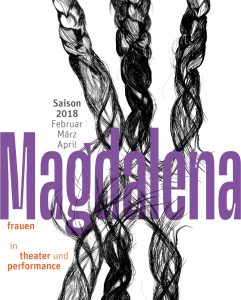 e countdown begins!
e countdown begins!
In less than two weeks, the Magdalena München Saison 2018 will open with a special evening of performances at HochX. We’ve been working on this project for almost a year – small team with limited resources, powered by a lot of wonderful Magdalena energy!
Today the first of our print material arrived from the printers: the Programm Leporello, and it looks beautiful! The last couple of weeks have been a hive of activity, so it’s exciting to hold one of the outcomes in my hands. Raquel Ro has worked late nights, Mira Mazumdar has worked on the translations, and Sabine Bollenbach has done precision proofreading. Designer, Carina Müller jumped in with some wonderful ideas that have really lifted our marketing materials to a new level. One special detail is the font that is used for the word “Magdalena”, This is a brand new font, not yet finished or publicly available, but its creator inge Plönnings has generously allowed us to use it. The lovely coincidence is that as well as being a stunning font, the name inge has given to this font is “Magnet”. Those of us who work on the Magdalena Project website refer to ourselves as “the Magnetics”, and we’re all part of the MAGdalena NETwork, so to have a font called Magnet is very appropriate!
The poster and flyers are now at the printers, email versions are about to fly into your inboxes, we have a press conference on Wednesday and the first international artists start arriving a few days later for their residencies at the Villa Waldberta. Right now it’s that luscious anticipatory period – I’m surrounded by lists, notes, emails, messages, a team of people, a flurry of organisation which in two weeks time will manifest as a fabulous opening evening.
Please join us on Friday 02.02., 19:00, at HochX Theater and Live Art for the Magdalena München Saison 2018 Opening Evening!
Riesgo de caída (“Vorsicht rutschig”)
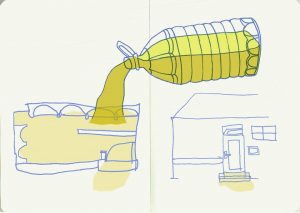 13.04. bis 28.04.: Installation, Das KloHäuschen
13.04. bis 28.04.: Installation, Das KloHäuschen- 13.04., 19:00: Eröffnung, Das KloHäuschen
- Infos auf KloHäuschen Webseite
Seife ist ein faszinierendes Material weil es durch Handarbeit hergestellt werden kann; Seife machen enthält eine fast magische chemische Reaktion; das Produkt in sich scheint mir durch seine Textur, das Schmelzen und Verschwinden auch sehr bedeutungsvoll. Mit Seife habe ich schon in anderen Kunstprojekten gearbeitet: in “The soap project”, 2005 war die Seife ein Medium, um mit dem Publikum eine persönliche Beziehung einzugehen; “Culo blanco”, 2016 war eine Performance mit Wäsche und Seife in der es um Erinnerungen aus meiner Kindheit ging.
Dieses Mal interessiert mich die Seife als Baustoff für meine Installation: ich mache damit einen Boden auf dem Boden des KloHäuschens. Einen rutschigen Boden. Dafür sammle ich altes Olivenöl, meistens von Landsleuten die in München leben, und ich werde vor Ort ein paar Tage mischen, wärmen und schütteln, fast wie ein Bauarbeiter. Und zum Ende meiner Zusammenarbeit mit dem KloHäuschen wird die Seife gebrochen und verteilt, benutzt und verschwinden.
Riesgo de caída (oder “Vorsicht rutschig”) weist auf die Idee hin, dass man als Mensch (und besonders als Frau) in der Gesellschaft immer dem Risiko unterliegt, auszurutschen oder hinzufallen. Wobei das wieder Aufstehen, den Faden wieder aufzunehmen, ein langer, rutschiger und mühsamer Weg sein kann. Tausend Mal gesagt aber vielleicht noch nicht richtig erkannt: eine männlich strukturierte Gesellschaft wird nie die Bedürfnisse von Frauen angemessen erfüllen können.
Alba Navas Salmerón, 1975, geboren in Sevilla, Spanien, studierte Bildende Kunst und Malerei in ihrer Heimat-Stadt. Nach einen Erasmus an der HdK in Berlin, folgte ein Master Studium in Bereich Public Art an der Bauhaus-Uni in Weimar. Von 2004 bis 2008 hat sie sich hauptsächlich mit Kunstprojekten im öffentlichen Raum beschäftig. Danach kam sie zurück ins Atelier. Farbe, Komposition und der Mensch als Wesen und Zuschauer haben sie von Anfang an geprägt. Diese Themen werden nicht nur in der Malerei behandelt, sondern prägen ihre Projekte in der Öffentlichkeit. Humor in Zusammenhang mit Kritik steht auch oft dabei. Sie lebt in München seit 2010, leitet eine Siebdruckwerkstatt im Leonrod Haus für Kunst, wo sie außerdem malt, zeichnet und neue Projekte konzipiert.
Riesgo de Caida – Caution, slippery
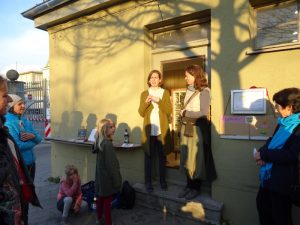
Soap is a fascinating material because it can be made by hand. Soap-making involves an almost magical chemical reaction. The product in itself seems to me very meaningful due to its texture, melting and disappearance. I have worked with soap in other art projects: in “The soap project”, in 2005 used soap as a medium to enter into a personal relationship with the audience; and “Culo blanco”, in 2016, was a performance with laundry and soap about my childhood memories.
This time, I am interested in soap as a building material for my installation: I will create a floor on the floor of the KloHäuschen. A slippery floor. I will collect old olive oil, mostly from friends living in Munich, which I will mix, warm and shake for a few days on site, almost like a construction worker. At the end of my collaboration with the toilet, the soap will be broken and distributed, used and disappeared.
Riesgo de caída (or “caution, slippery”) points to the idea that as a person (and especially as a woman) in society, you are always at risk of slipping or falling. But getting up again, picking up the thread, can be a long, slippery and tedious way. A thousand times said but perhaps not yet correctly recognized: a male-structured society will never adequately meet the needs of women.
Alba Navas Salmerón, born 1975 in Seville, Spain, studied fine arts and painting in her native city. She had an Erasmus scholarship at the HdK in Berlin, followed by a master’s degree in Public Art at the Bauhaus University in Weimar. From 2004 to 2008, she mainly dealt with art projects in public space. Then she returned to the studio. Color, composition and the human being as being and spectator have characterised her work from the beginning. These themes are not only dealt with in painting, but shape her projects in public. Humor in connection with criticism is also often included. She lives in Munich since 2010 and runs a screen printing workshop in the Leonrod Haus für Kunst, where she also paints, draws and designs new projects.
Dissociation
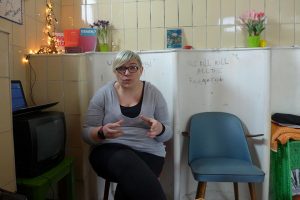 03.02., 09.02. und 10.02., 11:00 bis 18:00, das KloHäuschen
03.02., 09.02. und 10.02., 11:00 bis 18:00, das KloHäuschen- 23.02. 18:00- 20:00, Finissage, das KloHäuschen
- Information on Das KloHäuschen Webseite
Performative Installation: Zoe Gudović in Zusammenarbeit mit dem KloHäuschen
 Wie sieht Ihr “eigenes Zimmer” aus? Wo ist es und wie ist es eingerichtet?
Wie sieht Ihr “eigenes Zimmer” aus? Wo ist es und wie ist es eingerichtet?
Mit meiner Familie lebten wir zu sechst in einem 36-qm Apartment. Mein Wohnizimmer, also mein eigenes Zimmer, war die Toilette! Sie ist ein Raum, in dem sich mein Wissen und meine Gefühle entwickelt haben. Und so lade ich Sie ein, in meine Welt einzutreten, zum KloHäuschen auf eine Tasse Tee vorbeizukommen. Ich lade Sie ein auf eine Runde Wahrsagen aus Liebeskarten – und auf einen kurzen Film. Lassen Sie uns 15 MInuten damit verbringen, in Kontakt zu kommen, uns kennenlernen, zu teilen und zu lieben. Wollen wir das Thema “Haß” angehen – oder es einfach nur durch den Ton fühlen? – Sie werden es selber spüren und sich vielleicht danach davon lösen müssen! HInterlassen Sie Ihren Eindruck ganz frei auf einem Stück Klopapier!
Die performative Installation DISSOCIATION beginnt am 3. Februar 2018 im “KloHäuschen”. Am 3., 9. und 10. Februar wird Zoe jeweils von 11-18 Uhr dort vor Ort sein und Sie einladen für 15 Minuten ihr persönlicher Gast zu sein. Am 23. Februar von 18-20 Uhr findet ein “final event” beim KloHäuschen statt. DISSOCIATION entsteht in Zusammenarbeit von Zoe Gudovic mirt dem “KloHäuschen” für “Magdalena München Saison 2018” und wird gefördert von der Villa Waldberta, dem Kulturreferat der LH München und dem Goehe Institut Belgrad.
Performative Installation in collaboration with das KloHäuschen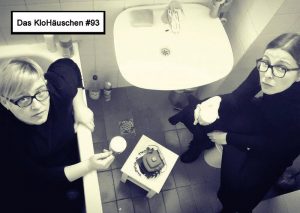
What does your “room of your own” look like? Where is it, how is it furnished?
I come from a family where six of us lived in a 36 square meter apartment. My living room, my room of my own, was the toilet! It is a space where my knowledge and emotions developed. So I invite you to step in to my world, to come to Das KloHäuschen for a cup of tea, a session of fortune telling from love cards, and a short movie. Let us spend this 15 minutes socializing, getting to know each other, sharing and loving. Shall we tackle the issue of hate, or just feel it through sounds – you will have to feel it yourself and maybe after disassociate from it! Leave your impressions on toilet paper, freely!
The performative installation DISSOCIATION begins on February 3, 2018 in the “KloHäuschen”. On the 3rd, 9th and 10th of February, Zoe will be there from 11am to 6pm, inviting you to be her personal guest for 15 minutes. On the 23rd of February from 6 pm to 8 pm there will be a final event at the KloHäuschen.
DISSOCIATION is a collaboration between Zoe Gudović and the “KloHäuschen” for the Magdalena München season 2018 and is supported by the Villa Waldberta, the cultural department of the LH Munich and the Goehe Institute Belgrade.
